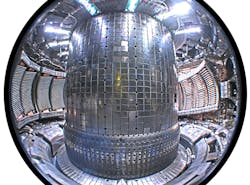The Alcator C-Mod tokamak nuclear-fusion reactor set a new world record for plasma pressure at MIT's Plasma Science and Fusion Center. Equipped with the technology to generate magnetic fields twice as strong as those in non-tokamak designs, it can produce quadruple their pressure, and beat their energy production 16-fold. The results were presented at the International Atomic Energy Agency Fusion Energy Conference, in Kyoto, Japan, on Oct. 17 by senior research scientist, Earl Marmar.
When the nuclei of plasma molecules fuse together due to a compression energy higher than that of their repulsion forces, they release energy that can be harnessed as electricity. The plasma must be dense and hot enough for this fusion to occur. Combined with MIT's research to create superconductive coils–-which induce magnetic fields at high efficiency with minimal current draw–-this breakthrough is expected to advance research in sustainable energy achieved by nuclear fusion.
During its 23 years of operation, the Alcator C-Mod reactor has repeatedly set the record for plasma pressure, increasing its fusion rate with each improvement. This time, it beat its 1.77-atmospheres record set in 2005 by 15%, reaching 2.05 atmospheres and temperatures twice as hot as the sun. Over the course of its 2-second lifetime, the plasma generated over 600-trillion fusions. The central magnetic field needed to produce the pressure was 5.4 Tesla, and the plasma carried 1.4-million amps of electrical current.
The record pressure was achieved on Acatar C-Mod's scheduled close date, which was set 3 years after funding by U.S. Congress. Research to advance the pressure record will be continued in the ITER tokamak reactor, which is under construction in France. Though 800 times larger than Alcator C-Mod, the U.S. Department of Energy expects ITER to achieve a record pressure of 2.6-atm under a lower magnetic field. Its completion date is set for 2032.
Scientists at MIT continue to conduct research that will improve the efficiency of commercial nuclear generators. By researching materials that become superconductors under very high temperatures, they would be able to induce magnetic fields without an external electrical power source. And with near-zero electrical resistance, these superconductors would generate minimal heat. High-temperature superconductor coils are also be central to the design for an Affordable Robust Compact (ARC) reactor conceptualized by MIT students in 2015, which would generate 250-million Watts of electricity.
About the Author
Leah Scully
Associate Content Producer
Leah Scully is a graduate of The College of New Jersey. She has a BS degree in Biomedical Engineering with a mechanical specialization. Leah is responsible for Machine Design’s news items that cover industry trends, research, and applied science and engineering, along with product galleries. Visit her on Facebook, or view her profile on LinkedIn.


